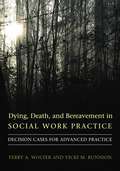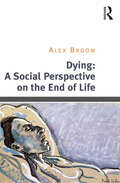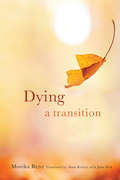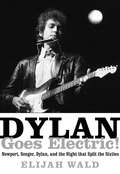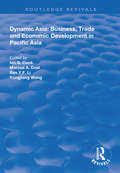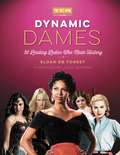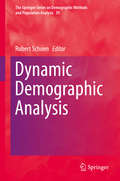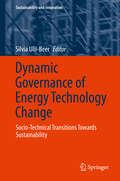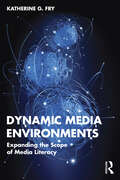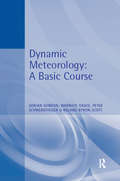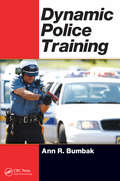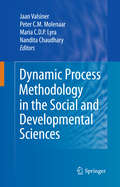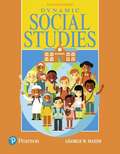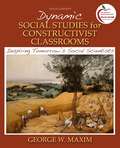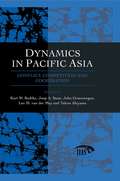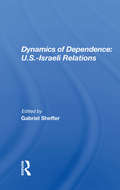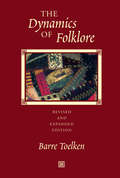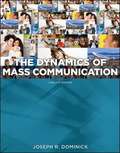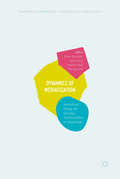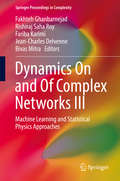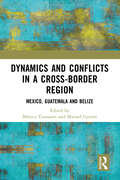- Table View
- List View
Dying, Death, and Bereavement in Social Work Practice: Decision Cases for Advanced Practice
by Wolfer Terry A. Vicki M. RunnionFeaturing twenty-three decision cases based on interviews with professional social workers, this unique volume allows students to wrestle with the often incomplete and conflicting information, ethical issues, and time constraints of actual cases.
Dying, Death, and Bereavement in Social Work Practice: Decision Cases for Advanced Practice
by Vicki M. Runnion Terry A. WolferPractitioners who work with clients at the end of their lives face difficult decisions concerning the client's self-determination, the kind of death he or she will have, and the prolongation of life. They must also remain sensitive to the beliefs and needs of family members and the legal, ethical, and spiritual ramifications of the client's death. Featuring twenty-three decision cases based on interviews with professional social workers, this unique volume allows students to wrestle with the often incomplete and conflicting information, ethical issues, and time constraints of actual cases. Instead of offering easy solutions, this book provides detailed accounts that provoke stimulating debates among students, enabling them to confront their own responses, beliefs, and uncertainties to hone their critical thinking and decision making skills for professional practice.*Please note: Teaching Notes for this volume will be available from Electronic Hallway in Spring 2010.To access the Teaching Notes, you must first become a member of the Electronic Hallway. The main Electronic Hallway web page is at https://hallway.org/index.php. To join, click Become a Hallway Member in the Get Involved category or point your browser directly to https://hallway.org/involved/join.php and provide the required information.After your instructor status has been confirmed, you will receive an email granting access to the Electronic Hallway. Once logged on to Electronic Hallway as a member, click Case Search in the Cases and Resources category on themain web page. Enter "death, dying, bereavement"(without the quotation marks) in the search box, select "all ofthe words" in the drop down menu, and click Submit. The search process will generate a list of Teaching Notes for cases from Dying, Death, and Bereavement in Social Work Practice: Decision Cases for Advanced Practice.
Dying, Death, and Bereavement in Social Work Practice: Decision Cases for Advanced Practice (End-of-Life Care: A Series)
by Terry Wolfer Vicki RunnionPractitioners who work with clients at the end of their lives face difficult decisions concerning the client's self-determination, the kind of death he or she will have, and the prolongation of life. They must also remain sensitive to the beliefs and needs of family members and the legal, ethical, and spiritual ramifications of the client's death. Featuring twenty-three decision cases based on interviews with professional social workers, this unique volume allows students to wrestle with the often incomplete and conflicting information, ethical issues, and time constraints of actual cases. Instead of offering easy solutions, this book provides detailed accounts that provoke stimulating debates among students, enabling them to confront their own responses, beliefs, and uncertainties to hone their critical thinking and decision making skills for professional practice.*Please note: Teaching Notes for this volume will be available from Electronic Hallway in Spring 2010.To access the Teaching Notes, you must first become a member of the Electronic Hallway. The main Electronic Hallway web page is at https://hallway.org/index.php. To join, click Become a Hallway Member in the Get Involved category or point your browser directly to https://hallway.org/involved/join.php and provide the required information. After your instructor status has been confirmed, you will receive an e-mail granting access to the Electronic Hallway. Once logged on to Electronic Hallway as a member, click Case Search in the Cases and Resources category on themain web page. Enter "death, dying, bereavement" (without the quotation marks) in the search box, select "all of the words" in the drop down menu, and click Submit. The search process will generate a list of Teaching Notes for cases from Dying, Death, and Bereavement in Social Work Practice: Decision Cases for Advanced Practice.
Dying: A Memoir
by Cory Taylor"Bracing and beautiful . . . Every human should read it." —The New York Times A New York Times Book Review Editors' Choice At the age of sixty, Cory Taylor is dying of melanoma-related brain cancer. Her illness is no longer treatable: she now weighs less than her neighbor’s retriever. As her body weakens, she describes the experience—the vulnerability and strength, the courage and humility, the anger and acceptance—of knowing she will soon die. Written in the space of a few weeks, in a tremendous creative surge, this powerful and beautiful memoir is a clear-eyed account of what dying teaches: Taylor describes the tangle of her feelings, remembers the lives and deaths of her parents, and examines why she would like to be able to choose the circumstances of her death. Taylor’s last words offer a vocabulary for readers to speak about the most difficult thing any of us will face. And while Dying: A Memoir is a deeply affecting meditation on death, it is also a funny and wise tribute to life.
Dying: A Social Perspective On The End Of Life
by Alex BroomAn inevitable and universal experience, dying is experienced by individuals in different ways, often related to the character of our relationships, family structures, gender identities, cultural backgrounds, and economic means. Drawing on extensive qualitative fieldwork with patients, carers and health professionals in Australia and the United Kingdom, Dying: A Social Perspective on the End of Life provides a critical examination of the different spheres of dying, in social and cultural context. Exploring complex issues such as the politics of assisted dying, negotiating medical futility, gender and dying, the desire for redemption, the moralities of 'the good fight' and the lived experience of bodily disintegration, this book links novel theoretical ideas within sociology to cutting-edge empirical data collected in palliative and end-of-life care contexts. A theoretically engaged understanding of the social mediation of the end of life, Dying: A Social Perspective on the End of Life also sheds light on the manner in which the end of life can be shaped by major economic, cultural and socio-cultural shifts including neo-liberalism, individualisation, medicalisation, professionalisation and detraditionalisation. As such, it will appeal to social science, health and medical researchers interested in the end of life, as well as those working in palliative and end-of-life care settings.
Dying: A Transition (End-of-Life Care: A Series)
by Monika RenzThis book introduces a process-based, patient-centered approach to palliative care that substantiates an indication-oriented treatment and radical reconsideration of our transition to death. Drawing on decades of work with terminally ill cancer patients and a trove of research on near-death experiences, Monika Renz encourages practitioners to not only safeguard patients' dignity as they die but also take stock of their verbal, nonverbal, and metaphorical cues as they progress, helping to personalize treatment and realize a more peaceful death. Renz divides dying into three parts: pre-transition, transition, and post-transition. As we die, all egoism and ego-centered perception fall away, bringing us to another state of consciousness, a different register of sensitivity, and an alternative dimension of spiritual connectedness. As patients pass through these stages, they offer nonverbal signals that indicate their gradual withdrawal from everyday consciousness. This transformation explains why emotional and spiritual issues become enhanced during the dying process. Relatives and practitioners are often deeply impressed and feel a sense of awe. Fear and struggle shift to trust and peace; denial melts into acceptance. At first, family problems and the need for reconciliation are urgent, but gradually these concerns fade. By delineating these processes, Renz helps practitioners grow more cognizant of the changing emotions and symptoms of the patients under their care, enabling them to respond with the utmost respect for their patients' dignity.
Dylan Goes Electric!: Newport, Seeger, Dylan, and the Night that Split the Sixties
by Elijah WaldTHE INSPIRATION FOR THE MAJOR MOTION PICTURE A COMPLETE UNKNOWN. One of the music world’s pre-eminent critics takes a fresh and much-needed look at the day Dylan “went electric” at the Newport Folk Festival.On the evening of July 25, 1965, Bob Dylan took the stage at Newport Folk Festival, backed by an electric band, and roared into his new rock hit, Like a Rolling Stone. The audience of committed folk purists and political activists who had hailed him as their acoustic prophet reacted with a mix of shock, booing, and scattered cheers. It was the shot heard round the world—Dylan’s declaration of musical independence, the end of the folk revival, and the birth of rock as the voice of a generation—and one of the defining moments in twentieth-century music.In Dylan Goes Electric!, Elijah Wald explores the cultural, political and historical context of this seminal event that embodies the transformative decade that was the sixties. Wald delves deep into the folk revival, the rise of rock, and the tensions between traditional and groundbreaking music to provide new insights into Dylan’s artistic evolution, his special affinity to blues, his complex relationship to the folk establishment and his sometime mentor Pete Seeger, and the ways he reshaped popular music forever. Breaking new ground on a story we think we know, Dylan Goes Electric! is a thoughtful, sharp appraisal of the controversial event at Newport and a nuanced, provocative, analysis of why it matters.“In this tour de force, Elijah Wald complicates the stick-figure myth of generational succession at Newport by doing justice to what he rightly calls Bob Dylan’s ‘declaration of independence’ . . . This is one of the very best accounts I’ve read of musicians fighting for their honor.” — Todd Gitlin, author of The Sixties and Occupy Nation
Dynamic Asia: Business, Trade and Economic Development in Pacific Asia (Routledge Revivals)
by Marcus A. Doel Ian G. Cook Rex Y.F. Li Yongjiang WangPublished in 1998, this book examines the challenges and opportunities for international business and trade in the Asia-Pacific region, highlighting the dynamic and complexities of the region.
Dynamic Dames: 50 Leading Ladies Who Made History (Turner Classic Movies)
by Sloan De ForestCelebrate 50 of the most empowering and unforgettable female characters ever to grace the screen, as well as the artists who brought them to vibrant life!From Scarlett O'Hara to Thelma and Louise to Wonder Woman, strong women have not only lit up the screen, they've inspired and fired our imaginations. Some dynamic women are naughty and some are nice, but all of them buck the narrow confines of their expected gender role -- whether by taking small steps or revolutionary strides.Through engaging profiles and more than 100 photographs, Dynamic Dames looks at fifty of the most inspiring female roles in film from the 1920s to today. The characters are discussed along with the exciting off-screen personalities and achievements of the actresses and, on occasion, female writers and directors, who brought them to life.Among the stars profiled in their most revolutionary roles are Bette Davis, Mae West, Barbara Stanwyck, Josephine Baker, Greta Garbo, Audrey Hepburn, Natalie Wood, Barbra Streisand, Julia Roberts, Meryl Streep, Joan Crawford, Vivien Leigh, Elizabeth Taylor, Dorothy Dandridge, Katharine Hepburn, Pam Grier, Jane Fonda, Gal Gadot, Emma Watson, Zhang Ziyi, Uma Thurman, Jennifer Lawrence, and many more.
Dynamic Demographic Analysis
by Robert SchoenThis volume presents state of the art analyses from scholars dealing with a range of demographic topics of current concern, including longevity, mortality and morbidity, migration, and how population composition impacts intergenerational transfer schemes. New approaches are applied to such issues as measuring changes in cohort survivorship in low mortality populations, patterns of mortality improvement at older ages, and the consequences of heterogeneity in the susceptibility to death. Studies examine models of the current status of the HIV/AIDS epidemic, advance present methods for estimating population change in small areas, and strive to disentangle age, period, and cohort effects. In sum, the book addresses key contemporary issues in measuring and modeling dynamic populations, and advances the frontier of dynamic demography.
Dynamic Governance of Energy Technology Change
by Silvia Ulli-BeerFormulating effective responses to the global challenges of mitigating climate change and securing a sustainable energy future requires a clear understanding of the interdependent causalities between institutions, local decision making, strategic alliances and eco-innovations, as well as policies. It has been acknowledged that the linear "Manhattan project" model is not an adequate governance model for mastering the dynamic complexity of socio-technical transitions; therefore this book aims at advancing research on systematic transition management models. It offers qualitative and quantitative analyses of socio-technical transitions in road transportation and housing, bringing together tailored theorizing on sustainability transitions and applied system dynamics modeling. It highlights the interconnected causal feedbacks that are required to overcome the lock-in situation in road transportation and housing fueled by fossil energies. Showing which concerted actions and framework conditions are required in the transition phases in order to initiate and sustain socio-technical transition, it serves as a guide to model-based strategy making, policy design and analyses in support of sustainable futures.
Dynamic Interpretation of Early Cities in Ancient China
by Hong XuThis book offers an archaeological study on China’s ancient capitals. Using abundant illustrations of ancient capital sites, it verifies the archaeological discoveries with documentary records. The author introduces the dynamical interpretation of each ancient capital to the interpretation of the entire development history of China's ancient capitals. The book points out that for most of the almost 2000 years from the earliest Erlitou (二里头)to the Ye city (邺城), there was an era where ancient capitals didn’t have outer enclosures due to factors such as the strong national power, the military and diplomatic advantage, the complexity of the residents, and the natural conditions. Thus an era of “the huge ancient capitals without guards” lasting for over 1000 years formed. The concept that “China’s ancient capitals don’t have outer enclosures” presented in the book questions the traditional view that “every settlement has walled enclosures”. Combining science with theory, it offers researchers of history a clear understanding of the development process of China’s ancient capitals.
Dynamic Media Environments: Expanding the Scope of Media Literacy
by Katherine G. FryAn accessible introduction to understanding the current media environment and the culture it contains, this book provides an indispensable guide to dynamic media literacy in the digital environment. Katherine G. Fry draws from philosophies of technology and communication, from media ecology, critical cultural theory, and critical pedagogy to explain the dimensions of media environments. Fry introduces an essential dynamic media environment model that can be used as a framework for understanding global social challenges. The model extends media literacy education and practice by de-centering media messages, instead explaining media as environments – as cultures created by and within our dominant form of communication. Exploring progressive education philosophies that advocate inclusion, independence, empathy, and critical thinking toward problem-solving in a rapidly changing world, this book includes media literacy examples, global case studies, exercises, and learning tools to facilitate learning the full scope of the current media environment. This book explores how the digital communication environment operates on many dimensions so that we, as citizens, as players within the shifting digital environment, can act to shape it. Essential reading for students and scholars of media and communication studies, media literacy, and media education, as well as other disciplines where media is used as a lens to examine issues within society.
Dynamic Meteorology: A Basic Course
by Adrian Gordon Warwick Grace Roland Byron-Scott Peter Schwerdtfeger'Dynamic Meteorology: A Basic Course' is an introduction to the physics of the atmosphere. Starting from the basics, it provides students with an awareness of simple mathematics and enthusiastically proceeds to provide a thorough grounding in the fundamentals of meteorology. The authors lead students to a scientifically rigorous understanding of the behaviour of weather systems such as highs, lows, fronts, jet streams and tropical cyclones. From the 'ABC' of the laws of Avogrado, Boyle and Charles to the powerful omega equation and beyond, this is a simple exposition of dynamic meteorology. Why does the wind blow along the lines of isobars rather than across them? Why are low pressure systems on the weather map more intense than high-pressure systems? Why is there much less constraint on the strength of the wind around a cyclone than an anticyclone? An international team of academic experts in meteorology answer these and many other fundamental questions with simple mathematical equations. Covering both northern and southern hemispheres, 'Dynamic Meteorology' equips students of earth and environmental sciences with proper understanding of the essential mathematics necessary to unlock the mysteries of the natural world.
Dynamic Police Training
by Ann R. BumbakAs police work has become increasingly professionalized, classrooms have become a preferred environment for training. However, the best preparation for police work has traditionally been conducted on the job. Dynamic Police Training partners the experienced law enforcement officers street-smart perspective of what makes training work with a professional educators book-smart approach to writing curriculum to achieve the best results in police training programs.
Dynamic Process Methodology in the Social and Developmental Sciences
by Maria C.D.P. Lyra Nandita Chaudhary Jaan Valsiner Peter C. MolenaarAll psychological processes--like biological and social ones--are dynamic. Phenomena of nature, society, and the human psyche are context bound, constantly changing, and variable. This feature of reality is often not recognized in the social sciences where we operate with averaged data and with homogeneous stereotypes, and consider our consistency to be the cornerstone of rational being. Yet we are all inconsistent in our actions within a day, or from, one day to the next, and much of such inconsistency is of positive value for our survival and development. Our inconsistent behaviors and thoughts may appear chaotic, yet there is generality within this highly variable dynamic. The task of scientific methodologies--qualitative and quantitative--is to find out what that generality is. It is the aim of this handbook to bring into one framework various directions of construction of methodology of the dynamic processes that exist in the social sciences at the beginning of the 21st century. This handbook is set up to bring together pertinent methodological scholarship from all over the world, and equally from the quantitative and qualitative orientations to methodology. In addition to consolidating the pertinent knowledge base for the purposes of its further growth, this book serves the major educational role of bringing practitioners--students, researchers, and professionals interested in applications--the state of the art know-how about how to think about extracting evidence from single cases, and about the formal mathematical-statistical tools to use for these purposes.
Dynamic Social Studies
by George MaximPractical and dynamic are the hallmarks of the popular Dynamic Social Studies , and this new edition steps up its focus with a fresh design and a number of updates that give readers a clear vision of the most effective ways to teach social studies to elementary school students--with the hope of inspiring them to become informed, rational, and culturally responsive citizens. Using a constructivist framework, key instructional approaches, literacy-based pedagogy, text sets, activities, and illustrative classroom scenarios, the book focuses on motivation, creativity, and the excellent examples of experienced teachers to help readers breathe life into their social studies teaching. <P><P> In addition to new, authentic classroom scenarios, the Eleventh Edition also includes four new chapters (5-8) that reflect current best practices and align to the College, Career, and Civic Life (C3) Framework for Social Studies Standards, and the Common Core Standards. Current, practical, and dynamic, this book provides the foundation that pre- and in-service teachers need to create the most effective, creative elementary social studies classrooms. The Enhanced Pearson eText version includes embedded video examples, video exploration exercises, and self-check quizzes.
Dynamic Social Studies for Constructivist Classrooms: Inspiring Tomorrow's Social Scientists (9th edition)
by George W. MaximThis is the basic premise of Dynamic Social Studies for Constructivist Classrooms-- taking advantage of children’s natural curiosity and built-in desire to learn. Because this ninth edition directs primary attention to capturing the natural learning style of children, students will be referred to as “young social scientists.” The young social scientists in our classrooms put subject matter to work to find and solve problems just like practicing social scientists do. This kind of teaching does not minimize the subject matter, for social scientists rarely find a powerful and interesting problem without substantial background knowledge. It simply suggests that subject matter can be put to work to stoke the curiosity in our students.
Dynamics In Pacific Asia: Conflict, Competition and Cooperation
by John Groenewegen Kurt W. Radtke Joop A. Stam Leo M. van der Mey Takuo AkiyamaFirst published in 1998. The writing of this book started in earnest with the establishment of a joint research group that gathered at the Netherlands Institute of Advanced Study (Wassenaar, The Hague) between September 1995 and June 1996. The starting point was the question, to what extent and in what way the new dynamics in (South)east Asia would influence Europe's global position, and more specifically, how these changes should be conceptualized in order to assist in the formulation of new policies to deal with the new international environment. Most contributors to this book would agree that there is ample reason to view these changes as an opportunity for Europe, and not just as a threat.
Dynamics Of Dependence: US.Iisraeli Relations
by Gabriel ShefferDespite Israel's enormous dependence on the United States, relatively little has been written by Israeli scholars about relations between the two countries. In this book of original essays, contributors discuss the social, ideological, and political groups in the United States that support or oppose Israel, examine how they influence policy decisions, and review U.S. public opinion toward Israel. In addition, the politics of supplying arms and economic aid to Israel are analyzed in historical perspective. Finally, the contributors explore the range of U.S. interests in the dispute over the West Bank.
Dynamics Of Folklore
by Barre ToelkenOne of the most comprehensive and widely praised introductions to folklore ever written. Toelken's discussion of the history and meaning of folklore is delivered in straightforward language, easily understood definitions, and a wealth of insightful and entertaining examples. Toelken emphasizes dynamism and variety in the vast array of folk expressions he examines, from "the biology of folklore," to occupational and ethnic lore, food ways, holidays, personal experience narratives, ballads, myths, proverbs, jokes, crafts, and others. Chapters are followed by bibliographical essays, and over 100 photographs illustrate the text. This new edition is accessible to all levels of folklore study and an essential text for classroom instruction.
Dynamics Of Mass Communication
by Joseph R. DominickWell-known for its balanced approach to media industries and professions, Dynamics of Mass Communication offers a lively, thorough, and objective introduction for mass communication majors and non-majors alike. Dynamics of Mass Communication takes a comprehensive and balanced look at the changing world of mass media. Social media, ‘apps’ and the new media Goliaths are new and major themes of the 12th edition. Explore how the traditional mass media are dealing with shrinking audiences, evaporating advertising revenue and increased competition from the Internet. The 12th edition brings students up-to-date on the latest developments in the media world including cyber-bullying; new media business models; e-book readers’ affects on the traditional print publishing industry; online video sites such as YouTube and hulu.com.; the decoupling of advertising from media content, and much more.
Dynamics Of Mediatization
by Andreas Hepp Olivier Driessens Göran Bolin Stig HjarvardThis volume sheds light on the underlying dynamics of mediatization, disentangling the actual unfolding of mediatization processes. The wide adoption and deep embedding of digital media and technology brings new questions to mediatization studies: how can we grasp this 'deep mediatization'? In which way should we develop existing approaches of mediatization to analyse such dynamics? What are the consequences of this for theorising and empirically studying mediatization? By using these questions as a starting point, this book presents an innovative and original collection that is dedicated to both the underlying dynamics of mediatization and recent dynamics related to digital media.
Dynamics On and Of Complex Networks III: Machine Learning and Statistical Physics Approaches (Springer Proceedings in Complexity)
by Bivas Mitra Fakhteh Ghanbarnejad Rishiraj Saha Roy Fariba Karimi Jean-Charles DelvenneThis book bridges the gap between advances in the communities of computer science and physics--namely machine learning and statistical physics. It contains diverse but relevant topics in statistical physics, complex systems, network theory, and machine learning. Examples of such topics are: predicting missing links, higher-order generative modeling of networks, inferring network structure by tracking the evolution and dynamics of digital traces, recommender systems, and diffusion processes.The book contains extended versions of high-quality submissions received at the workshop, Dynamics On and Of Complex Networks (doocn.org), together with new invited contributions. The chapters will benefit a diverse community of researchers. The book is suitable for graduate students, postdoctoral researchers and professors of various disciplines including sociology, physics, mathematics, and computer science.
Dynamics and Conflicts in a Cross-Border Region: Mexico, Guatemala and Belize (Latin American History in Translation)
by Mónica Toussaint Marisol GarzónThis volume explores several issues pertinent to the history of the cross-border region between Mexico, Guatemala and Belize from new explanatory approaches in order to reflect on a history and a reality that are shared by three neighbouring societies, emphasizing the actors and local practices that shape cross-border dynamics. This analysis is contributed by eight specialists who study aspects that are fundamental to our understanding of a process involving various persons and institutions in a specific space. Dynamics and Conflicts in a Cross-Border Region addresses an issue of current relevance through studies that focus on the problems inhabitants of the region have faced over the years: the realities of a porous border; the existence of family, trade and cultural ties that surpass the administrative limits negotiated by the states late in the 19th century; the impact of the internal conflicts of neighbour countries in the border space; experiences of exile and refuge at the border and the violence they entail; the role of local authorities in managing regional problems; the pending task of cross-border territorial organization; the efforts of local institutions to promote regional development; and the presence of phenomena like contraband, drug trafficking, organized crime and human trafficking in an increasingly complex and challenging space. This provides a way to use the region’s history as a springboard for conceiving of mechanisms by which we can together face the challenges presented today to the inhabitants of the cross-border region between Mexico, Guatemala and Belize. This book will be a valuable resource for students and scholars of Latin American history and Social History.
